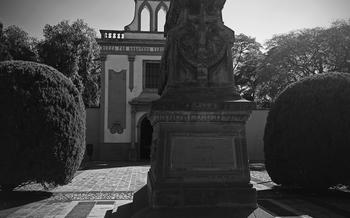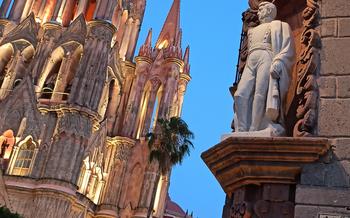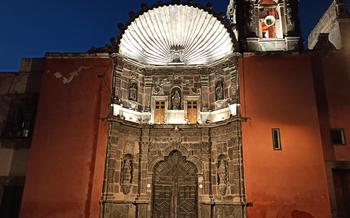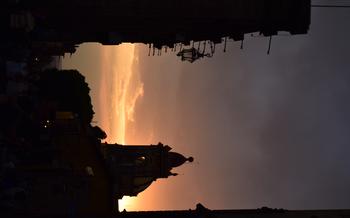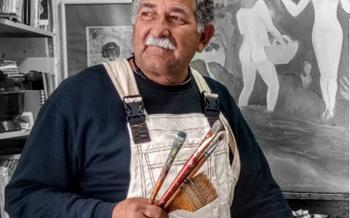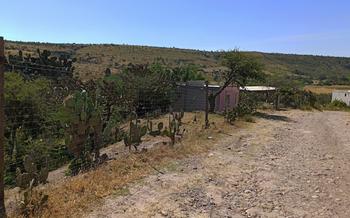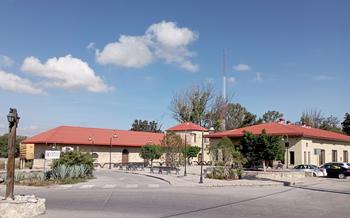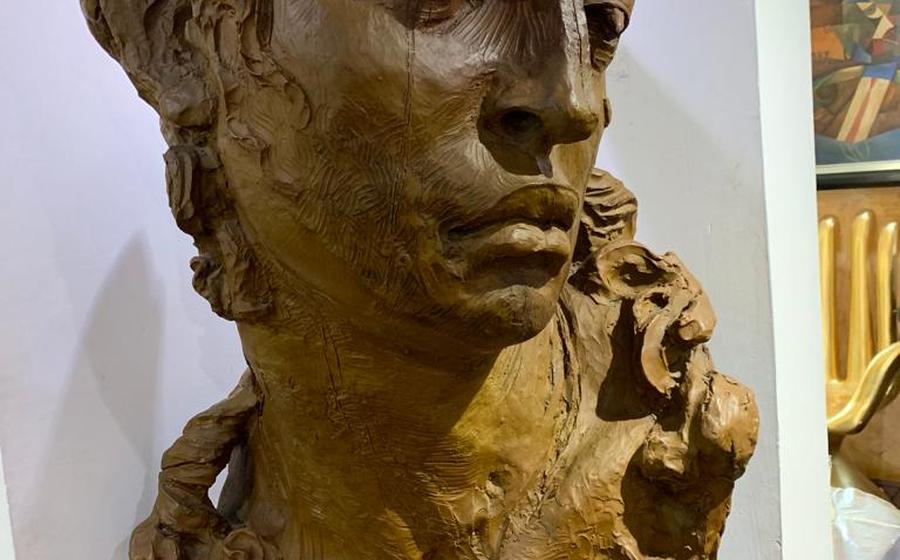
Leyendas y Mitos de Queretaro
- The Legend of the Founding of Queretaro
- The Legend of the Queretana Witch
- The Myth of the Queretaro Tunnels
- Tips for Exploring the Queretaro Tunnels
- Safety Precautions
- The Legend of the Queretana Treasure
- The Myth of the Queretana Ghost
- The Legend of the Queretana Miracle
- The Myth of the Queretana Curse
- The Myth of the Queretana Hero
- The Legend of the Queretana Festival
- The Myth of the Queretana Cuisine
- The Legend of the Queretana Crafts:
- Insider Tip: The Secret Courtyard of the Queretana Witch
The Legend of the Founding of Queretaro
According to legend, the founding of Queretaro was guided by a divine prophecy and the intervention of a mysterious figure known as the 'Gigante de la Peña' (Giant of the Rock). The story begins with a group of Otomi and Purépecha tribes who, seeking a new homeland, were led by a wise old man named Conín. Guided by a divine voice, they arrived at a valley surrounded by hills and mountains.
At the center of the valley stood an impressive monolith, the Peña de Bernal, which the tribes believed to be the home of the gods. As they settled in the valley, they noticed that the giant monolith seemed to change shape and form, sometimes resembling a human figure. This led to the legend of the 'Gigante de la Peña' who they believed guarded the valley and protected its people.
The giant's presence brought prosperity and protection to the tribes, and they named the valley 'Querétaro', which means 'Place of the Giants' in the Otomi language. The name Queretaro thus carries a deep mythological and historical significance, representing the fusion of indigenous beliefs and Spanish colonial influences that shaped the city's identity.
The Legend of the Queretana Witch
In the heart of Queretaro, a captivating legend unfolds, telling the tale of a beautiful witch who captivated the city with her enchanting presence. This mesmerizing figure, known as the Queretana Witch, possessed otherworldly powers and used her charms to weave a spellbinding aura over the city.
The origins of this legend are shrouded in mystery, with various theories and tales intertwining to create a rich tapestry of folklore. Some say that she was a powerful sorceress who arrived in Queretaro from a distant land, seeking refuge from persecution. Others whisper that she was a local woman who discovered ancient secrets and gained mystical abilities.
Regardless of her origins, the Queretana Witch became a prominent figure in the city's history. Her beauty and allure ensnared the hearts of many, both men and women, who fell under her enchanting spell. She possessed the power to heal the sick, predict the future, and even control the elements, leaving an indelible mark on the city and its people.
As the legend evolved, the Queretana Witch became a symbol of both admiration and fear. Some revered her as a benevolent figure who used her powers for good, while others whispered tales of her darker side, warning of her ability to curse those who crossed her path.
Over time, the legend of the Queretana Witch became deeply embedded in the fabric of Queretaro's culture and identity. Her story continues to be told and retold, captivating the imaginations of generations, and serving as a reminder of the city's rich and vibrant history.
The Myth of the Queretaro Tunnels
Legends of secret tunnels and underground passages abound in Queretaro. Some claim they were built by the Spanish conquistadors to transport gold and silver from the mines to the city, while others say they were used by rebels and revolutionaries to escape from the authorities. There are even stories of tunnels that lead to hidden chambers and treasures.
While there is no definitive proof of the existence of these tunnels, there is some historical evidence to support their existence. In the 17th century, a Spanish chronicler wrote about a tunnel that connected the city of Queretaro with the nearby town of San Juan del Río. And in the 19th century, a group of treasure hunters claimed to have found a tunnel that led to a hidden chamber filled with gold and jewels.
Whether or not the Queretaro tunnels actually exist, they remain a fascinating part of the city's folklore. They are a reminder of the city's rich history and the many secrets that it still holds.
Tips for Exploring the Queretaro Tunnels
If you are interested in exploring the Queretaro tunnels, there are a few things you should keep in mind.
- First, be sure to do your research and learn about the history of the tunnels. This will help you to understand what you are looking for and to avoid getting lost.
- Second, be sure to bring a flashlight and a map. The tunnels can be dark and confusing, so it is important to have a way to see and to navigate.
- Third, be sure to wear comfortable shoes and clothing. You will be doing a lot of walking, so you want to be comfortable.
- Fourth, be sure to be respectful of the tunnels and their history. These tunnels are not just tourist attractions; they are also part of the city's heritage.
Safety Precautions
Exploring the Queretaro tunnels can be a safe and enjoyable experience, but there are a few safety precautions you should take.
- First, be sure to go with a friend or group. Never explore the tunnels alone.
- Second, be sure to tell someone where you are going and when you expect to be back.
- Third, be sure to stay on the marked paths and avoid exploring any areas that are not well-lit.
- Fourth, be sure to be aware of your surroundings and be on the lookout for any potential dangers.
The Legend of the Queretana Treasure
In the heart of Queretaro, legends of hidden treasures and lost fortunes dance on the wind. These tales, woven with threads of history and myth, speak of buried riches, conquistadors' gold, and the allure of untold wealth.
One such legend tells of a vast treasure hidden by the Spanish conquistadors as they retreated from the city in the 16th century. The fortune, they say, was concealed within a secret tunnel beneath the city's aqueduct, guarded by ancient spells and curses.
Another tale whispers of a lost silver mine, hidden deep in the mountains surrounding Queretaro. Legend has it that a group of miners discovered a vein of pure silver, but their greed led to their downfall. The mine collapsed, entombing the miners and their precious treasure within its depths.
These legends, passed down through generations, have fueled the dreams of treasure hunters and adventurers alike. While no concrete evidence of these hidden riches has ever been found, the allure of the Queretana treasure remains strong.
Tips for Treasure Hunting and Exploring Historical Sites in Queretaro:
Research: Delve into the history of Queretaro and its legends to identify potential sites for treasure hunting or historical exploration.
Local Knowledge: Engage with locals, listen to their stories, and seek their advice on potential treasure sites or historical landmarks.
Permits and Safety: Obtain necessary permits and ensure your safety by following local regulations and guidelines when exploring historical sites or engaging in treasure hunting activities.
Respect: Be respectful of the local culture and environment, and avoid disturbing or damaging historical sites or artifacts.
Share Your Findings: If you do discover any historical artifacts or information, share your findings with local authorities or historical societies to contribute to the preservation and understanding of Queretaro's rich heritage.
The Myth of the Queretana Ghost
The city of Queretaro is steeped in history and folklore, and its many legends and myths include tales of restless spirits and haunted places. These stories often stem from historical events and tragedies that have occurred within the city walls. One such legend is the story of the Queretana Ghost, a woman who was brutally murdered and now haunts the streets of the city, seeking revenge.
According to the legend, the Queretana Ghost was a beautiful young woman who was killed by her jealous husband. He brutally stabbed her to death and then buried her body in the courtyard of their home. However, the woman's spirit could not find peace and returned to haunt the streets of Queretaro, seeking revenge on her husband and anyone who stood in her way.
Local tradition holds that the Queretana Ghost can be seen wandering the streets of the city at night, her body covered in blood and her eyes filled with rage. She is said to be particularly vengeful towards men, and she will often attack them if they get too close. Some people believe that the ghost is also responsible for the strange noises and apparitions that are often reported in the city's historic center.
Whether you believe in ghosts or not, the legend of the Queretana Ghost is a fascinating glimpse into the rich folklore of Queretaro. It is a story that has been passed down from generation to generation, and it continues to captivate the imaginations of locals and visitors alike.
The Legend of the Queretana Miracle
In the heart of Queretaro, faith and spirituality intertwine with the legend of the Queretana Miracle. Stories of divine interventions and miraculous events have shaped the city's religious and cultural identity, leaving an indelible mark on its history.
According to legend, in times of adversity, the people of Queretaro turned to their faith for guidance and protection. Miraculous healings, answered prayers, and divine interventions became a source of hope and resilience for the community.
One of the most cherished stories tells of a young woman named Maria, who was stricken with a debilitating illness. As her condition worsened, her family and friends prayed fervently for her recovery. In a moment of desperation, they carried her to the Church of San Francisco, seeking divine intervention.
As the priest laid his hands on Maria and prayed, a miraculous healing occurred. The illness vanished, and Maria was restored to perfect health. The news of this miracle spread like wildfire, strengthening the community's faith and belief in the power of prayer.
The legend of the Queretana Miracle is a testament to the deep-rooted spirituality of the city's inhabitants. It serves as a reminder that even in the darkest of times, hope and faith can prevail, bringing about miraculous transformations.
The Myth of the Queretana Curse
In the tapestry of Queretaro's legends, the Myth of the Queretana Curse looms as a somber thread, weaving tales of misfortune and ill luck that have haunted the city's past. These curses, often associated with specific places or objects, are deeply rooted in historical events and tragedies that have left an indelible mark on the collective psyche.
One such curse is said to cling to the Hacienda de la Capilla, a sprawling estate steeped in a tragic love story. According to legend, a young woman named Luisa fell in love with a poor peasant, defying the wishes of her wealthy family. In a fit of rage, her father cursed Luisa and the hacienda, condemning it to eternal misfortune. Visitors to the hacienda often report feelings of unease and strange occurrences, as if the weight of the curse still lingers within its walls.
Another curse is associated with the Queretana Witch, a mysterious figure shrouded in both fear and fascination. Legend has it that the witch was once a beautiful woman who was betrayed by her lover. Driven by vengeance, she cursed the city, condemning it to misfortune and sorrow. To this day, some believe that the witch's curse continues to cast a shadow over Queretaro, bringing bad luck and misfortune to those who cross her path.
These curses, though intangible, have become an integral part of Queretaro's folklore, adding a layer of mystery and intrigue to the city's already rich history. While some dismiss them as mere superstition, others believe they hold a grain of truth, a testament to the power of belief and the enduring legacy of the past.
The Myth of the Queretana Hero
Queretaro's rich history and cultural heritage are intertwined with tales of brave heroes whose deeds have shaped the city's identity and inspired generations. These legends celebrate the courage, resilience, and selflessness of individuals who stood up for justice, fought for freedom, and made significant contributions to Queretaro's development.
One of the most famous heroes in Queretaro's mythology is Ignacio Allende, a military leader who played a pivotal role in the Mexican War of Independence. Allende was born in San Miguel de Allende, a city in the state of Guanajuato, but he spent a significant part of his life in Queretaro, where he helped organize the independence movement. He is remembered for his bravery and leadership during the Battle of Monte de las Cruces, where he fought against the Spanish colonial forces. Although Allende was eventually captured and executed, his legacy lives on as a symbol of courage and patriotism.
Another legendary hero from Queretaro is Josefa Ortiz de Domínguez, known as La Corregidora, who played a crucial role in the early stages of the independence movement. La Corregidora was the wife of the corregidor (mayor) of Queretaro, and she used her position to secretly organize meetings and provide information to the rebel leaders. Her actions were instrumental in the planning and execution of the conspiracy that led to the Grito de Dolores, the rallying cry that marked the beginning of the Mexican War of Independence. La Corregidora is remembered for her bravery, intelligence, and dedication to the cause of freedom.
These are just a few examples of the many heroes who have left their mark on Queretaro's history. Their stories are passed down through generations, inspiring locals and visitors alike to embrace the values of courage, integrity, and selflessness. By learning about these legendary figures, we gain a deeper appreciation for the rich cultural heritage of Queretaro and the spirit of its people.
The Legend of the Queretana Festival
Queretaro's festivals are a vibrant tapestry of music, dance, and tradition, each with its own unique story and significance. The Festival of the Holy Cross, held every May, commemorates the finding of a sacred cross by a shepherd boy in the 16th century. The Festival of the Virgin of Guadalupe, celebrated on December 12, honors the patron saint of Mexico with processions, fireworks, and traditional dances.
The Queretaro International Film Festival, held annually in September, showcases films from around the world and attracts filmmakers and movie enthusiasts alike. The Queretaro Jazz Festival, held in November, features performances by renowned jazz musicians from Mexico and abroad.
These festivals are not just spectacles; they are an integral part of Queretaro's identity. They bring people together, celebrate the city's rich cultural heritage, and create memories that last a lifetime. Whether you're a local or a visitor, immersing yourself in Queretaro's festivals is a must-do experience.
Tips for experiencing Queretaro's festivals:
-
Plan ahead: Check festival dates and schedules in advance to make sure you don't miss out on any major events.
-
Be prepared for crowds: Queretaro's festivals attract large crowds, so be prepared for jostling and long lines.
-
Dress comfortably: You'll be doing a lot of walking and dancing, so wear comfortable shoes and clothing.
-
Bring cash: Many vendors at festivals only accept cash, so make sure you have enough on hand.
-
Be respectful: Remember that these festivals are cultural events, so be respectful of local customs and traditions.
The Myth of the Queretana Cuisine
Queretaro's cuisine is a delicious and diverse blend of flavors, influenced by its rich history and cultural heritage. Legends abound about the origins and uniqueness of Queretana cuisine, adding an extra layer of intrigue to the city's culinary scene.
One popular legend tells the tale of a magical cooking pot that was discovered by a group of travelers in the mountains surrounding Queretaro. The pot was said to have the ability to cook any dish to perfection, and it soon became a prized possession of the city's rulers. The legend goes on to say that the pot was eventually lost, but its secrets were passed down from generation to generation, contributing to the development of Queretaro's unique culinary traditions.
Another legend attributes the city's culinary prowess to a group of fairies who were said to live in the forests near Queretaro. These fairies were skilled cooks, and they would often share their recipes with the local people. As a result, Queretana cuisine is said to be infused with a touch of fairy magic, giving it a flavor that is unlike anything else in the world.
Queretaro's cuisine is a true reflection of the city's vibrant culture and history. From the traditional dishes that have been passed down through generations to the innovative creations of modern chefs, Queretaro's culinary scene is a must-experience for any traveler.
The Legend of the Queretana Crafts:
Queretaro's artisans are renowned for their exceptional skills in crafting beautiful and intricate objects. The city's rich history and cultural diversity are reflected in its vibrant arts and crafts scene. Local artisans use traditional techniques and materials to create unique pieces that showcase their creativity and craftsmanship.
One of the most iconic Queretana crafts is the "sarape", a colorful blanket or shawl made from wool or cotton. The sarape is a symbol of the city and is often worn by locals during festivals and special occasions. Visitors can find a wide variety of sarapes in Queretaro's markets and shops, each with its own unique design and pattern.
Another popular Queretana craft is "majolica", a type of pottery that is characterized by its bright colors and intricate designs. Majolica pottery is often used to make plates, bowls, tiles, and other decorative items. Visitors can find beautiful majolica pieces in Queretaro's art galleries and ceramics workshops.
Queretaro is also known for its "leatherwork". Local artisans use high-quality leather to create a variety of products, including shoes, bags, belts, and wallets. Queretana leatherwork is renowned for its durability and craftsmanship, and visitors can find a wide range of leather goods in the city's shops and markets.
Exploring Queretaro's traditional crafts is a wonderful way to learn about the city's history and culture. Visitors can find unique and beautiful handmade items that make for perfect souvenirs or gifts. Whether you're looking for a colorful sarape, a piece of intricate majolica pottery, or a stylish leather bag, Queretaro's artisans have something to offer everyone.
Insider Tip: The Secret Courtyard of the Queretana Witch
In the heart of Queretaro's historic center lies a hidden gem, a secluded courtyard said to be the former abode of the legendary Queretana Witch. Nestled amidst quaint colonial buildings, this tranquil oasis is veiled from the bustling streets, accessible only through an inconspicuous doorway.
Upon entering, you'll be transported to a realm of enchantment. The courtyard is adorned with intricate murals depicting scenes from the witch's life, and the air is filled with the scent of jasmine and herbs, remnants of her potent spells.
Legend has it that the witch, known for her kindness and healing abilities, once resided here, using her powers to help those in need. Visitors to the courtyard often leave offerings of flowers or coins, seeking her blessings or paying homage to her spirit.
While the witch's existence remains shrouded in mystery, the courtyard stands as a testament to the enduring power of Queretaro's legends. Take a moment to sit on the ancient stone bench, soak in the tranquility, and let your imagination wander as you contemplate the tales of the Queretana Witch.

